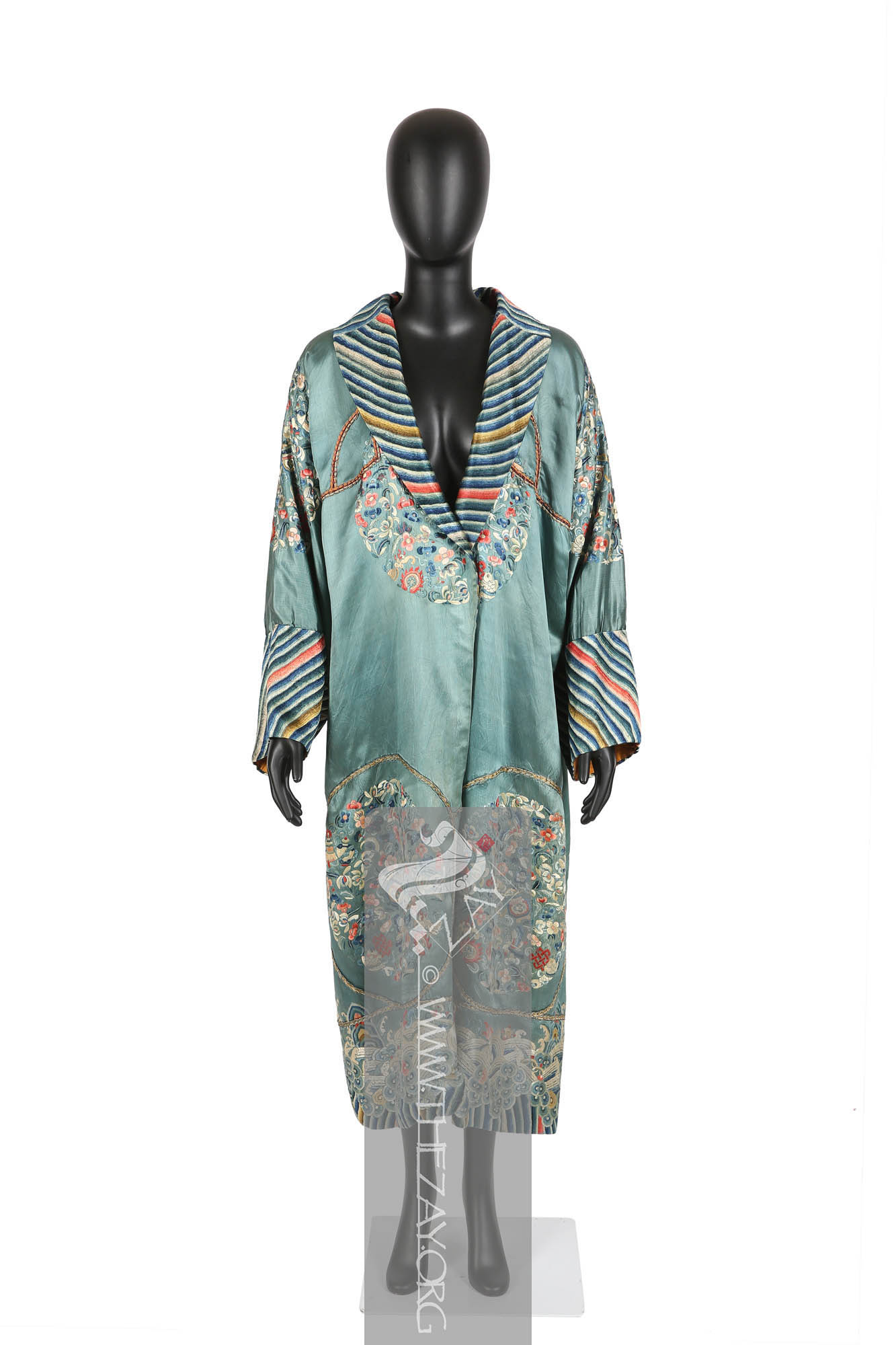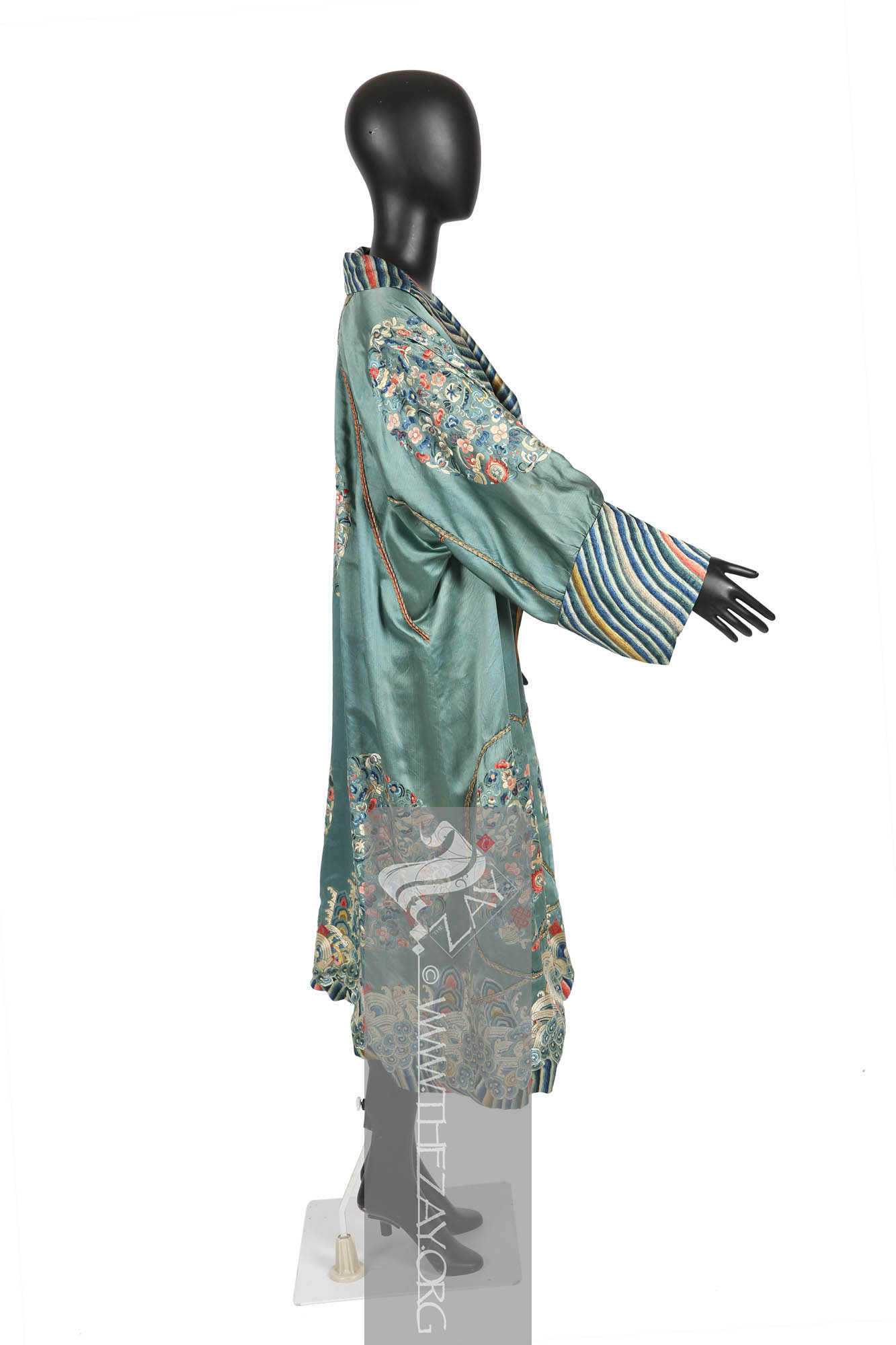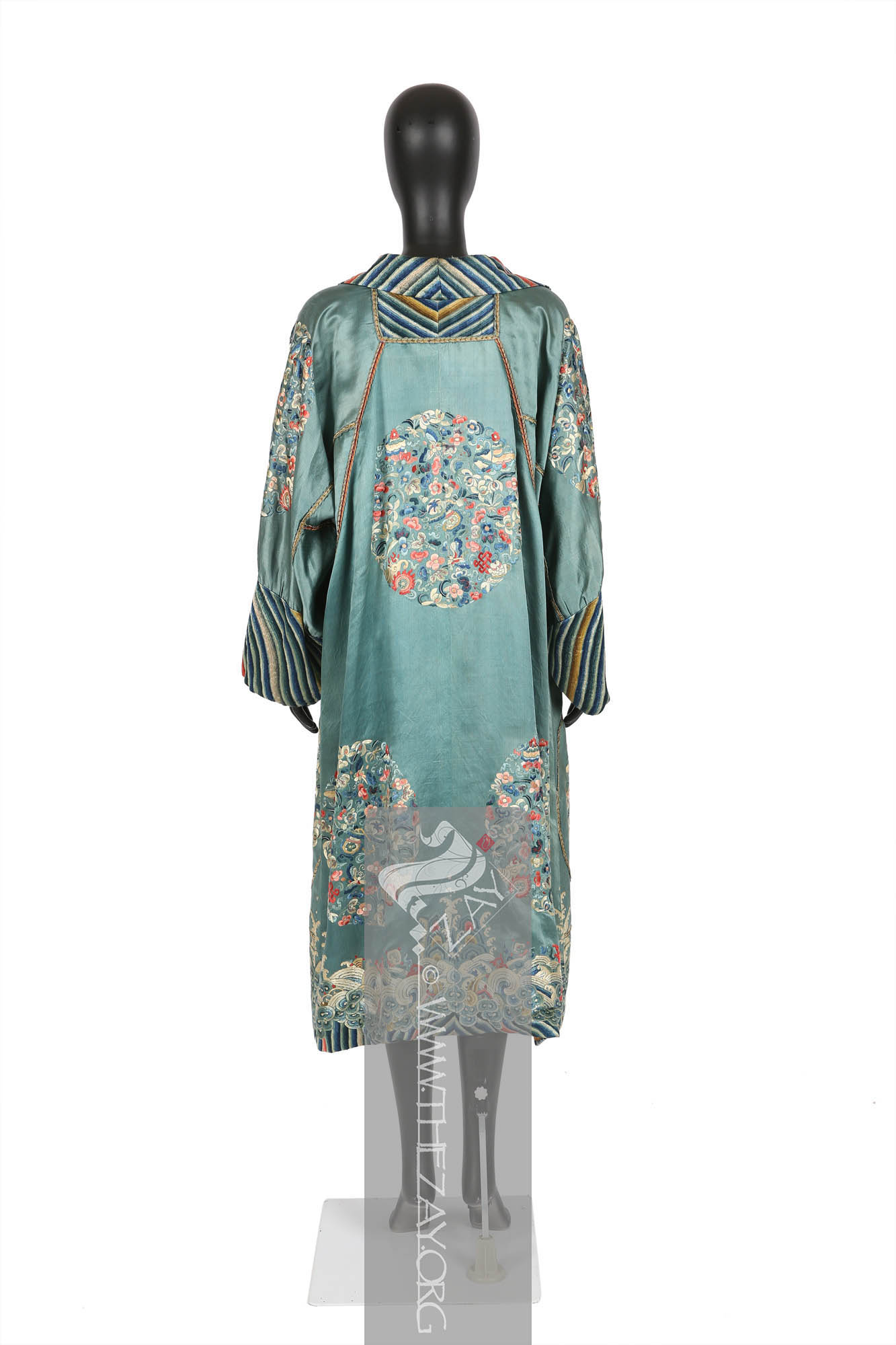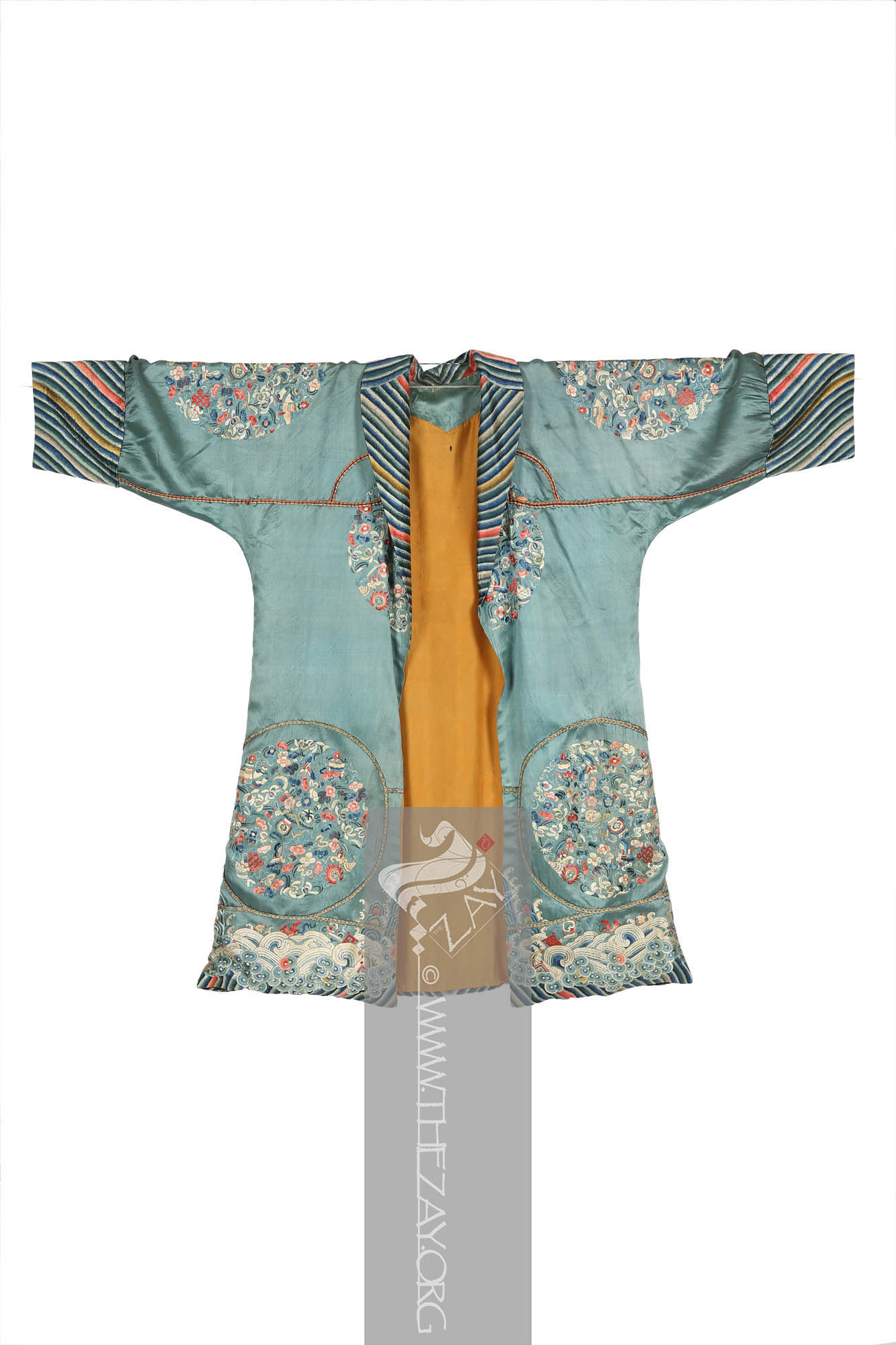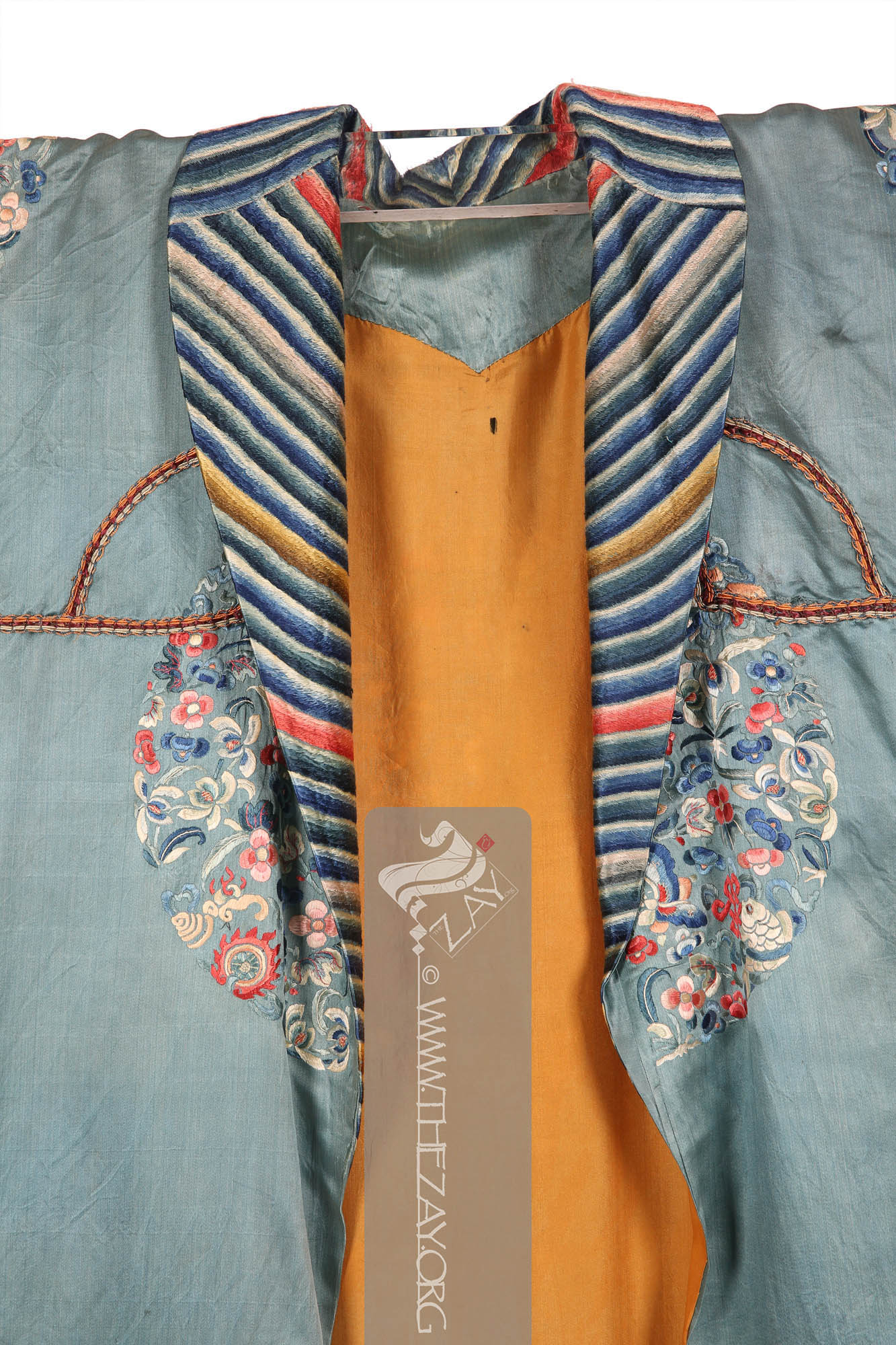Object HistoryThis western-style silk women’s long coat in (
satin
Sātin: (Arabic: Zaytuni: from Chinese port of Zayton in Quanzhou province where it was exported from and acquired by Arab merchants), one of the three basic types of woven fabric with a glossy top surface and a dull back. Originated in China and was fundamentally woven in silk.) weave was purchased by Dr. Reem El Mutwalli for enhancing the collection of the
Zay
Zay: (Arabic: costume, Pl. azyaā’), a set of clothes in a style typical of a particular country or historical period. Initiative in 2015 from a dealer in London.
Object FeaturesThis is a lovely teal blue colour women’s silk long jacket in a
satin
Sātin: (Arabic: Zaytuni: from Chinese port of Zayton in Quanzhou province where it was exported from and acquired by Arab merchants), one of the three basic types of woven fabric with a glossy top surface and a dull back. Originated in China and was fundamentally woven in silk. weave. It is a western-style jacket with broad lapelled collars, and full sleeves, and reaches the wearer’s low calf. It is embellished mostly with (
satin_stitch
Satin_stitch: (Synonym: Damask Stitch), is a type of flat embroidery stitch that creates a satin like smooth and shiny surface by closely spaced stitches, covering an entire area or shape.) and (
chain_stitch
Chain_stitch: An embroidery technique where a looped stitch is made in a continuous chain-like pattern. Each stitch is formed by looping the thread through the previous stitch, creating a linked chain. ) embroidery in silk
floss
Floss: (Old French: flosche – nap of velvet), is a type of silk fibre obtained from the cocoons of wild silkworms. It is characterized by its long, fluffy fibers that are not tightly woven, making it ideal for use in various textile applications such as embroidery, lace-making, and sewing. and metal threads.
Although it is a Western-style jacket, it is clear from its design elements and embellishment styles that it in fact has been repurposed from a Chinese Qing period – 1644-1912 – (
jifupao
Jifupao: (Chinese: jifu – Auspicious dress); were traditional Chinese robes worn by noble men and women and their family members for prominent family occasions outside of the court. ) or auspicious robe popularly worn by noble women and wives of imperial officers during important family occasions in a domestic setting – away from the court.
The jacket is embellished with eight roundels scattered all across its field. These roundels are filled with motifs of elements and signs auspicious and symbolic of Buddhist beliefs embroidered in shades of pink, ivory,
coral
Coral: (Greek: korallion, probably from Hebrew: goral – small pebbles), is a pale to medium shade of pink with orange or peach undertones, resembling the colour of certain species of coral., blue, and grey silk
floss
Floss: (Old French: flosche – nap of velvet), is a type of silk fibre obtained from the cocoons of wild silkworms. It is characterized by its long, fluffy fibers that are not tightly woven, making it ideal for use in various textile applications such as embroidery, lace-making, and sewing. threads.
The immediately recognisable symbols in each roundel are the Buddhists' emblems auspicious objects for good fortune. They are the fish symbolising abundance, the conch shell symbolising the call for worship, the endless knot for long life, the lotus for unblemished purity, the wheel of law, and the ping or sacred vase that holds the water of life.
Apart from these, the other recognisable motifs are that of the flame and the flaming pearls symbolising wealth and success.
The bottom of the jacket has (
lishui
Lishui: (Chinese: lishui – standing water) or (stripes), is a set of multicoloured diagonal lines either straight or wavy running parallel to each other forming a pattern that depicts calm sea waves. ) stripes which were clearly removed and reused to construct the lapels for the collar and the broad cuffs of the sleeves. A series of
chain_stitch
Chain_stitch: An embroidery technique where a looped stitch is made in a continuous chain-like pattern. Each stitch is formed by looping the thread through the previous stitch, creating a linked chain. embroidery runs along the jacket’s bust and back. This is possibly to cover up different parts that were cut and then stitched together in different positions for repurposing and redesigning the original piece.
Links
- https://digitalcommons.unl.edu/cgi/viewcontent.cgi?article=1106&context=tsaconf
- https://www.youtube.com/watch?v=KrXWXKoq2GY
- https://www.youtube.com/watch?v=Ef28p8MtMaU
- https://www.youtube.com/watch?v=TWfu_mWNnUY
- https://www.youtube.com/watch?v=CPvzuVOYEsE
- https://www.youtube.com/watch?v=zdBeGFHxmAc
- https://www.needlework-tips-and-techniques.com/cutwork
Cutwork: It is a surface embroidery technique using two main stitches – the running stitch and the buttonhole stitch and is usually made on fine linen or cotton with threads that match the fabric colour. It creates a lace like pattern while the stitches prevent the fabric from fraying. -embroidery.html
- https://www.christies.com/features/Chinese-robes-collecting-guide-7813-1.aspx
- https://www.christies.com/en/lot/lot-6130068
- https://onlineonly.christies.com/s/art-asia/blue-ground-kesi
Kesi: (Chinese: kesi – cut silk), a weaving technique in Chinese silk tapestry
Tapestry: wall hanging or other large piece of fabric that is woven in coloured weft threads or embroidered with a decorative design. Typically made of wool, but they can also be made of other materials such as silk, linen, or cotton. Often used to decorate homes, churches, and other buildings. using short length weft threads with each colour using a separate bobbin. The threads are tucked into the textile in such a way that only the weft threads are visible in the finished fabric. -surcoat
Surcoat: (Old French: sur – over), is a loose robe or outer coat that could sometimes be worn over an armour and is worn as a part of an insignia of an order of imperial guards or a knighthood. -longgua-655/156157
- https://exchange.umma.umich.edu/resources/26228#
- https://www.ngv.vic.gov.au/wpcontent/uploads/2020/07/Sheet7_AsianEduRes_A4_sheets
- https://artsandculture.google.com/story/reading-a-dragon-robe/EwIywfDtcg-mKg
- https://www.metmuseum.org/art/collection/search/68920
- https://nazmiyalantiquerugs.com/blog/kesi
Kesi: (Chinese: kesi – cut silk), a weaving technique in Chinese silk tapestry
Tapestry: wall hanging or other large piece of fabric that is woven in coloured weft threads or embroidered with a decorative design. Typically made of wool, but they can also be made of other materials such as silk, linen, or cotton. Often used to decorate homes, churches, and other buildings. using short length weft threads with each colour using a separate bobbin. The threads are tucked into the textile in such a way that only the weft threads are visible in the finished fabric. -chinese-tapestry
Tapestry: wall hanging or other large piece of fabric that is woven in coloured weft threads or embroidered with a decorative design. Typically made of wool, but they can also be made of other materials such as silk, linen, or cotton. Often used to decorate homes, churches, and other buildings. /
- https://www.wei-yee.com/craftsmanship/kesi
Kesi: (Chinese: kesi – cut silk), a weaving technique in Chinese silk tapestry
Tapestry: wall hanging or other large piece of fabric that is woven in coloured weft threads or embroidered with a decorative design. Typically made of wool, but they can also be made of other materials such as silk, linen, or cotton. Often used to decorate homes, churches, and other buildings. using short length weft threads with each colour using a separate bobbin. The threads are tucked into the textile in such a way that only the weft threads are visible in the finished fabric. -chinese-silk-tapestry
Tapestry: wall hanging or other large piece of fabric that is woven in coloured weft threads or embroidered with a decorative design. Typically made of wool, but they can also be made of other materials such as silk, linen, or cotton. Often used to decorate homes, churches, and other buildings. -weaving
- https://www.britannica.com/art/kesi
Kesi: (Chinese: kesi – cut silk), a weaving technique in Chinese silk tapestry
Tapestry: wall hanging or other large piece of fabric that is woven in coloured weft threads or embroidered with a decorative design. Typically made of wool, but they can also be made of other materials such as silk, linen, or cotton. Often used to decorate homes, churches, and other buildings. using short length weft threads with each colour using a separate bobbin. The threads are tucked into the textile in such a way that only the weft threads are visible in the finished fabric.
- https://encyclocraftsapr.com/kesi
Kesi: (Chinese: kesi – cut silk), a weaving technique in Chinese silk tapestry
Tapestry: wall hanging or other large piece of fabric that is woven in coloured weft threads or embroidered with a decorative design. Typically made of wool, but they can also be made of other materials such as silk, linen, or cotton. Often used to decorate homes, churches, and other buildings. using short length weft threads with each colour using a separate bobbin. The threads are tucked into the textile in such a way that only the weft threads are visible in the finished fabric. /
- https://australian.museum/learn/cultures/international-collection/chinese/mandarin
- https://www.penn.museum/collections/highlights/highlight.php?irn=4025
- https://www.penn.museum/collections/object/246110




